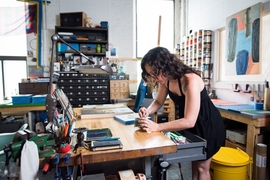As a PhD student in philosophy, Rebecca Millsop is working on doctoral research that’s a little different than most at MIT.
“It’s thinking, writing, talking to people, doing some more thinking, and reading every once in a while,” she says with a laugh.
However, for her this process has been a highly fruitful one that has led her to successfully address a highly contentious question in philosophy: How do we define art?
Combining art and logic
After high school, Millsop enrolled in the San Francisco Art Institute, where she studied conceptual art. She and her classmates spent their time creating art and critiquing each other’s work, and it was this process that pushed her to start thinking about the definition of art.
“My second year I started considering the fact that I'm not going to be able to make art unless I know what it is,” she recalls. “So I decided to drop out of art school and study philosophy.”
Millsop’s quest for answers landed her in a philosophy program at the City College of San Francisco, and it was there that she fell in love with logic, which she continued to pursue while earning her bachelor’s degree at the University of California at Berkeley.
As an undergraduate, Millsop delved into areas of logic ranging from structural (what happens when you take all the content out of a logic problem and look at the connectors such as “and” and “or” that are left behind) to historical (her honors thesis explores the work of famous philosopher Immanuel Kant.) It was when Millsop read a paper by MIT philosophy professor Vann McGee, however, that her next step became clear.
“I was actually really frustrated with the paper. I was really challenged by the paper,” she says. “But I really loved it, so I wanted to go to MIT.”
Millsop arrived at MIT with the goal of doing logic and mathematics, and for the first two years of her PhD that’s exactly what she did — until a class on the philosophy of social science with Ford International Professor Sally Haslanger, which caused her earlier questions about art to resurface.
“I was reminded of being in art school and thinking about how difficult it was for a lot of individuals to engage with contemporary art because of its rarefied nature and the institution of art making it difficult for people to approach the nature of art itself,” she says. “I can remember sitting in this seminar and really feeling for the first time in graduate school that, yes, I have real opinions about this, this is something that I feel is important. The passion was there.”
What is art?
For her dissertation, Millsop decided to tackle the biggest question that drove her to leave art school so many years before: What is art?
To get at this question, she had to consider the three main existing definitions of art: the aesthetic (which relies completely on subjective viewer experience), institutional (where art is anything museums or galleries consider art), and historical (where current art is defined by those things considered art in the past). Each of these definitions excludes important examples of art, to the point where some philosophers decided maybe art just can’t be defined, an outcome Millsop found wholly unsatisfying.
“You have to consider that art is a very real part of our lives and societies, we have art institutions, we have funding for the arts, everyone has an idea of what it is,” she says. “[Works of art] are real things that interact with real people in the world, so we should care about coming up with satisfactory definitions, or at least theories.”
The starting point of Millsop’s quest came from an unlikely place: biology. Specifically, species pluralism, the theory that comes out of the fact that there are 20 different definitions of a species used by biologists in different contexts.
“Some of these definitions can’t even capture everything that we want to capture at all,” says Millsop. “However, biologists work with all of them just fine, and they use them for different things. The idea with art pluralism is just taking that idea and plopping it into art.”
Millsop got to work reading dozens of papers in the philosophy of biology, and devoted part one of her dissertation to strengthening the argument for art pluralism put forth in an earlier work by philosophers Christy Mag Uidhir and P.D. Magnus. Millsop used species pluralism to make the case for art pluralism, but by the end of her paper, she was brimming with new questions, such as how do the definitions of art relate to each other? Is there some unifying quality?
In part two of her dissertation, Millsop took on some of these questions, arguing that pluralism involves multiple definitions having a specific structural relationship to one another (termed a “complex kind”), which is essentially the all-encompassing definition for that thing. Again, she relied on species pluralism in biology to make her point, explaining that there isn’t just one, catch-all definition of a species, but rather a variety of related definitions that come together in a specific structure.
Once she had successfully explained the concept of a complex kind, Millsop was finally ready to use it to answer her original question: What is art?
To do so, Millsop devoted part three of her dissertation to figuring out the structural relationship that exists between the aesthetic, institutional, and historical definitions of art. Her conclusion? The aesthetic definition of art, which relies on subjective viewer experience is, in many ways, the most important one.
“The aesthetic experiences we have with works of art give us the freedom to think about the artwork unconstrained by a lot of the typical assumptions and rules and moral boundaries that we have in everyday life,” she says. “They allow for this conversation between you and the artwork exploring what's right, what's wrong, how the world is, what other cultures are like. I think that's why we have art institutions. I think that's why art can change people's minds, can have political power, can be propaganda. It has a certain kind of power that can be harnessed for good or bad.”
Of course, the institutional and historical definitions of art still must be factored in, and Millsop considers them to be “focally looping” on the aesthetic, meaning they influence our conversations about art, and play a role in the evolution of art over time. They also work well as real-world definitions of art, since they are more concrete.
New challenges
For Millsop, the final stage of her dissertation has provided a satisfying answer to her initial question, but it has also given her a lot more to think about. In particular, she has been grappling with how she can engage people in her research and how art in general can be made accessible for a general audience, which has led her to delve into the philosophy of education.
“We really need to focus on how we teach art, because a lot of people don't think of art as the aesthetic, experiential, valuable thing that I'm talking about,” she explains. “We need to educate every individual in our society to feel comfortable and empowered to go up to a work of art and reflect on it from their own perspective, and feel like they are coming from a place of power.”
Millsop uncovered her own love of teaching while teaching undergraduate philosophy classes at MIT, and as she nears the end of her doctoral program, she has begun thinking about ways to focus her academic research and praxis to art education, and she is also considering expanding her dissertation into a book aimed at a general audience.
It was no accident that around the same time Millsop switched her dissertation topic to the definition of art, she also restarted her own painting practice. Throughout graduate school, it has provided her with a much-needed outlet, a sanctuary where she can temporarily set aside all of her deep philosophical questions and reconnect with art on the most fundamental level — by creating it.












